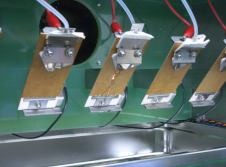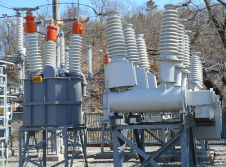High voltage inclined-plane tracking test for electric vehicles
Electric vehicle (EV), which has become rapidly prevailing recently, requires further development of large capacity, high output, and quick charging.
This is the global trend and the frameworks for EV specification of next-generation are being made beyond barriers between private and public sectors, and between various industries.
In addition to that, new car-technology has been developing dramatically such as automatic driving, IoT, and connected cars.
The components such as batteries, motors, power supplying facilities, and controller devices are essential components for EV with high capacity, high output, and quick charging and the electrical characteristics of the insulation materials used for these key components especially the tracking resistance performance, will be more demanding in the future.
Charging voltages which will be required in coming generation and the after are shown in below.
In the future, the voltage will be greatly increased for quick charging.

| Framework of charging voltage | At Present | Next generation (Specification determined in 2018) |
Generation after next (Specification to be determined in 2020) |
|---|---|---|---|
| Charging voltage | 100V or 200V | 1000V | 1500V |
Insulating performance evaluation-Tracking resistance and Erosion resistance test
(Inclined-plane method, IEC60587, JIS C2136, ASTM D2303)
To evaluate insulating performance around energized part, comparative tracking index according to IEC60112, ASTM D3638 e.g. is used, but testable voltage is only up to 600V.
Tracking performance of insulating polymer material for outdoor use is tested by "Test methods for evaluating resistance to tracking and erosion under severe ambient conditions" based on IEC60587 or JIS C2136. Samples should be inclined at an angle of 45 degrees, and be attached with electrodes at the top and bottom, and then be applied with specified voltage between the electrodes, while electrolytic solution should run from the top electrodes to the bottom. Tracking occurs from the bottom, and then the time is measured for tracking to climb up for 20mm from the bottom electrode. This is how to confirm tracking performance (carbonization) and erosion resistance (erosion) characteristics.
Tracking performance of insulating polymer material for outdoor use is tested by "Test methods for evaluating resistance to tracking and erosion under severe ambient conditions" based on IEC60587 or JIS C2136. Samples should be inclined at an angle of 45 degrees, and be attached with electrodes at the top and bottom, and then be applied with specified voltage between the electrodes, while electrolytic solution should run from the top electrodes to the bottom. Tracking occurs from the bottom, and then the time is measured for tracking to climb up for 20mm from the bottom electrode. This is how to confirm tracking performance (carbonization) and erosion resistance (erosion) characteristics.

Insulating polymer materials used under severe conditions
Power transmission or distribution line and outdoor electric facilities are used with higher voltages compared with indoor equipment.
Widely used insulating materials for these devices are porcelain insulators and porcelain bushings.
However, these porcelain insulating parts have some disadvantages. They have poor shock resistance and thus are easy to break, and what is more, too heavy for regular maintenance.
On the other hand, polymer materials have been increasingly applied to outdoor insulating because of its characteristics such as light weight, high resistant to shock, easy maintenance, and great resistance for contamination.

List of Standards
| Test | Standard No. | Standard | Target |
|---|---|---|---|
| Inclined-plane tracking test | IEC60587 | Electrical insulating materials used under severe ambient conditions -Test methods for evaluating resistance to tracking and erosion | Polymer materials used under severe outdoor conditions |
| JIS C2136 | Electrical insulating solid materials used under severe ambient conditions -Test methods for evaluating resistance to tracking and erosion | Polymer materials used under severe outdoor conditions | |
| ASTM D2303 | Liquid-Contaminant, Inclined-Plane Tracking and Erosion of Insulating Materials1 | Insulating materials |
Contact information
PIC: Makoto Horimizu (Mr.)
Phone: +81-551-42-5061

